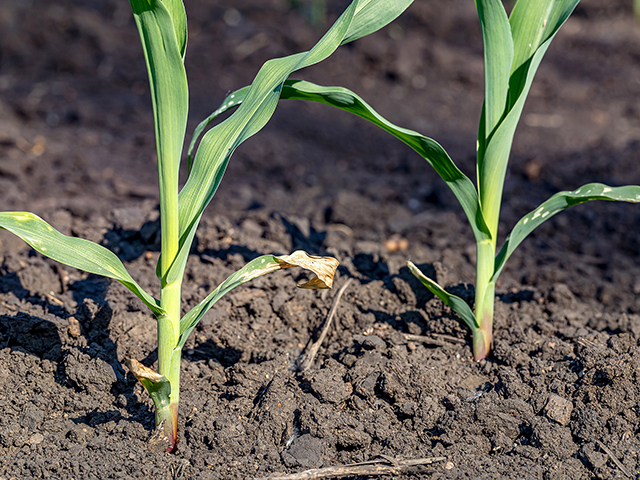Smart Sulfur Strategies
Smart Sulfur Strategies - Sulfur Is Essential for Optimum Plant Growth
ADVERTORIAL
Known as the fourth major nutrient, sulfur is a critical component of a balanced crop fertilization program to optimize yield. Smart Sulfur Strategies, brought to you by Smart Nutrition(TM) MAP+MST(R), provides information and insights on the vital role sulfur plays to enhance production on every acre and maximize your crop nutrition investment.
Sulfur is critical for plant growth. It is one of 17 essential nutrients and plays a vital role in photosynthesis and nitrogen fixation. "It is used in the production of chlorophyll formation leading to photosynthesis. Plants really can't live without it," says Cristie Preston, senior agronomist with Nutrien. "Making sure you have enough sulfur in your fertility program is key to maximizing production."
KNOW DEFICIENCY SYMPTOMS
It's vital to identify sulfur versus nitrogen symptoms to alleviate possible sulfur deficiencies. "While both nutrients are mobile in the soil, only nitrogen translocates within the corn plant," Preston says. "Since both sulfur and nitrogen cause leaf yellowing, nitrogen deficiency shows up in the oldest corn leaves, while sulfur yellowing shows up as a distinct striping on the younger leaves at the top of the plant."
As roots continue to grow and reach more nutrients in the soil, these symptoms can go away. "When organic matter breaks down, it releases plant-available sulfate-sulfur for root uptake," she says. One rule of thumb is that 3 to 5 pounds of sulfur are annually mineralized for each percent organic matter in the top 6 inches of soil. The timing of mineralization is dependent on soil microorganisms, slowed by cold and wet soils in the spring.
P[L1] D[0x0] M[300x250] OOP[F] ADUNIT[] T[]
Leaching of sulfur out of the root zone can also occur with excessive rainfall on well-drained, coarse-textured soils, although not as rapidly as nitrate-nitrogen.
TEST FOR DEFICIENCIES?
Soil analytical approaches may be decent in some geographies, but not all. Even trying to pinpoint how much sulfur will become available as organic matter mineralizes is difficult.
"Tissue sampling, as a diagnostic tool rather than for actual rate recommendations, can offer future fertility improvement," Preston adds. "Comparing sample results between chlorotic and healthy areas of fields can help verify the presence of sulfur deficiency and lead to better fertilizer decisions in subsequent years."
CALCULATE SULFUR REMOVAL RATES
A good strategy to determine sulfur rate focuses on previous crop removal of sulfur, plus consider yield goals for the current season. "The best way to correct sulfur deficiency is to schedule enough of the nutrient in your fertility program," she explains.
Corn (grain harvest) removes approximately 16 to 20 pounds of sulfur per acre (for 200-bushel corn). An 80-bushel-per-acre wheat crop removes about 8 pounds of sulfur per acre. Research conducted in Iowa on corn shows a sulfur application rate of 15 pounds per acre for fine-textured soils and 25 pounds per acre on course-textured soils if sulfur deficiency is anticipated.
"Proper balance of sulfur with nitrogen is important because too much nitrogen can make sulfur deficiency worse," explains Preston.
POSSIBLE SOYBEAN BENEFITS
With higher soybean protein levels desired on the global market, early research with foliar application of sulfur and nitrogen at the R1 growth stage is showing potential. "With soybeans, like adding protein in wheat, the crop needs an adequate balance of sulfur with nitrogen for protein synthesis," Preston says.
THE NEED FOR SULFUR FERTILIZATION:
Farmers must either rely on sulfur that is already present in their fields or apply it as fertilizer. Adding sulfur to your fertilization program is much more cost effective than correcting a sulfur deficiency once it occurs. Smart Nutrition MAP+MST is a great option for adding sulfur to your soil and supplying crops with some of the key nutrients they need throughout the growing season.
(C)2021 Nutrien Ltd.; SMART NUTRITION, NUTRIEN logos and designs are registered trademarks owned by Nutrien Ltd. MST(R) logos and designs are registered trademarks owned and used under license by Sulvaris Inc.
[PF_0221]
(c) Copyright 2021 DTN, LLC. All rights reserved.




